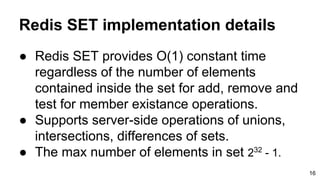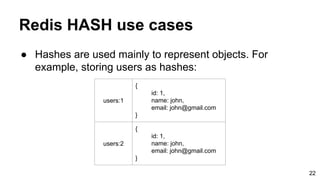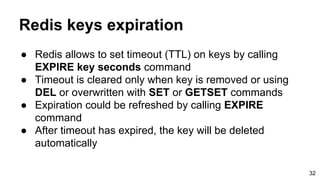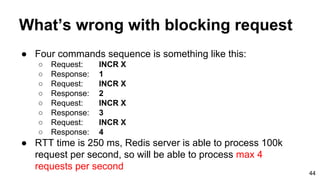Redis basics
- 1. Redis Basics by Arthur Shvetsov CoreValue/MalkosUA
- 2. Agenda ● What is Redis? ● Data structures overview ● Data modeling examples ● Keys expiration ● Redis transactions ● Redis pub/sub ● Pipelining 2
- 3. What is Redis? ● In-memory key-value store, with persistence ● Open source, written in C ● Extremely fast and lightweight ● Binary-safe keys with supported expiration ● High level data structures ● Support for atomic operations and transactions ● Internal scripting with LUA ● Master-slave replication ● Tons of client libraries for all major languages 3
- 4. History ● REmote DIctionary Server ● Released in March 2009 by Salvatore Sanfilippo ● Built in order to scale http://lloogg.com/ ● According to the monthly ranking by DB- Engines.com, Redis is the most popular key- value store 4
- 5. How to install? ● http://redis.io/download ● The Redis project does not officially support Windows. ● Microsoft Open Tech group develops and maintains this Windows port targeting Win64. 5
- 6. Redis implementation details ● Redis is a TCP server using the client-server model. ● Redis protocol - simple and efficient text-based protocol called RESP (REdis Serialization Protocol). ● Every Redis command is atomic, including the ones that do multiple things. ● Redis is single-threaded, which is how every command is guaranteed to be atomic. While one command is executing, no other command will run. 6
- 7. Data structures overview Key ● STRING - binary-safe string with max allowed size 512 MB Value ● Primitives ○ STRING - Strings, integers, or floating point values ● Containers (of strings) ○ LIST - Linked list of strings ○ SET - Unordered collection of unique strings ○ HASH - Unordered hash table of keys to values ○ ZSET - Ordered mapping of string members to floating- point scores, ordered by score 7
- 8. Redis STRING The Redis String type is the simplest type of value you can associate with a Redis key. Integer and float numbers can be stored as STRING type in Redis. hello world string Key name Type of value Value stored Command What it does GET Fetches the data stored at the given key SET Sets the value stored at the given key DEL Deletes the value stored at the given key (works for all types) 8
- 9. Redis STRING examples redis> SET hello world OK redis> GET hello "world" redis> DEL hello (integer) 1 redis> GET hello (nil) redis> SET counter 100 OK redis> INCR counter (integer) 101 redis> INCR counter (integer) 102 redis> INCRBY counter 50 (integer) 152 9
- 10. Redis STRING use cases ● Use Strings to store serialized JSON/XML/etc data ● Use Strings as atomic counters using commands in the INCR family: INCR, DECR, INCRBY. ● Append to strings with the APPEND command. Use Strings as a random access vectors with GETRANGE and SETRANGE. 10
- 11. Redis LIST LISTs in Redis is a sequence of order strings, implemented using a Linked List. list-key item item2 item list Key name Type of value List of values, duplicates possible Command What it does RPUSH Pushes the value onto the right end of the list LRANGE Fetches a range of values from the list LINDEX Fetches an item at a given position in the list LPOP Pops the value from the left end of the list and returns it 11
- 12. Redis LIST implementation details ● The max length of a list is 232 - 1 elements (4294967295, more than 4 billion of elements per list). ● Redis lists are implemented via Linked Lists. ● The operation of adding a new element in the head or in the tail of the list is performed in constant time. ● Accessing an element by index is very fast near the head and tail of the list, but O(N) operation in the middle. 12
- 13. Redis LIST examples redis> RPUSH list-key item (integer) 1 redis> RPUSH list-key item2 (integer) 2 redis> RPUSH list-key item (integer) 3 redis> LRANGE list-key 0 -1 1) "item" 2) "item2" 3) "item" redis> LINDEX list-key 1 "item2" redis> LPOP list-key "item" redis> LRANGE list-key 0 -1 1) "item2" 2) "item" 13
- 14. Redis LIST use cases ● Model a timeline, for example in a social network, using LPUSH in order to add new elements in the user time line, and using LRANGE in order to retrieve a few of recently inserted items. ● You can use LPUSH together with LTRIM to create a list that never exceeds a given number of elements, but just remembers the latest N elements. ● Lists can be used as a message passing primitive. 14
- 15. Redis SET In Redis, SETs are similar to LISTs in that they’re a sequence of strings, but unlike LISTs, Redis SETs use a hash table to keep all strings unique. set-key item2 item item3 set Key name Type of value Set of distinct values, undefined order Command What it does SADD Adds the item to the set SMEMBERS Returns the entire set of items SISMEMBER Checks if an item is in the set SREM Removes the item from the set, if it exists 15
- 16. Redis SET implementation details ● Redis SET provides O(1) constant time regardless of the number of elements contained inside the set for add, remove and test for member existance operations. ● Supports server-side operations of unions, intersections, differences of sets. ● The max number of elements in set 232 - 1. 16
- 17. redis> SADD set-key item (integer) 1 redis> SADD set-key item2 (integer) 1 redis> SADD set-key item3 (integer) 1 redis> SADD set-key item (integer) 0 redis> SMEMBERS set-key 1) "item" 2) "item2" 3) "item3" Redis SET examples redis> SISMEMBER set-key item4 (integer) 0 redis> SISMEMBER set-key item (integer) 1 redis> SREM set-key item2 (integer) 1 redis> SREM set-key item2 (integer) 0 redis> SMEMBERS set-key 1) "item" 2) "item3" 17
- 18. Redis SET use cases ● Use SETs to track unique things, for example unique IP addresses or user ids visiting a web page. ● Sets are good to represent relations between objects. For example 1 to many relation could be represented as a set order: 1234:items → [234, 555, 674] 18
- 19. Redis HASH Redis HASHes store a mapping of keys to values. The values that can be stored in HASHes are strings and numbers. hash-key sub-key-1 sub-key-2 hash Key name Type of value Distinct keys, undefined order Command What it does HSET Stores the value at the key in the hash HGET Fetches the value at the given hash key HGETALL Fetches the entire hash HDEL Removes a key from the hash, if it exists Values associated with the key value-1 value-2 19
- 20. Redis HASH implementation details ● The max number of elements in hash 232 - 1. ● A hash with a few fields (where few means up to one hundred or so) is stored in a way that takes very little space, so you can store millions of objects in a small Redis instance. 20
- 21. redis> HSET hash-key sub-key1 value1 (integer) 1 redis> HSET hash-key sub-key2 value2 (integer) 1 redis> HSET hash-key sub-key1 value1 (integer) 0 redis> HGETALL hash-key 1) "sub-key1" 2) "value1" 3) "sub-key2" 4) "value2" Redis HASH examples redis> HDEL hash-key sub-key2 (integer) 1 redis> HDEL hash-key sub-key2 (integer) 0 redis> HGET hash-key sub-key1 "value1" redis> HGETALL hash-key 1) "sub-key1" 2) "value1" 21
- 22. ● Hashes are used mainly to represent objects. For example, storing users as hashes: Redis HASH use cases users:1 { id: 1, name: john, email: [email protected] } users:2 { id: 1, name: john, email: [email protected] } 22
- 23. Shopping cart example cart cart_line Redis model SET cart:john → [ 1, 3 ] SET cart:james → [ 2 ] HASH cart:1 { user: “john”, status: “submitted” } HASH cart:2 { user: “james”, status: “in progress” } HASH cart:1:products [ 28: 1, 372: 2 ] HASH cart:2:products [ 15: 5, 160: 4 ] CartID User Status 1 john Submitted 2 james In Progress 3 john Submitted CartID ProductID Quantity 1 28 1 1 372 2 2 15 5 2 160 4 23
- 24. Redis ZSET ZSET (Sorted set) is a data type which is similar to a mix between a Set and a Hash. Every element (called member) in a sorted set is associated with a floating point value (called score). zset-key member1 member2 zset Key name Type of value Named members, ordered by associated score Command What it does ZADD Adds member with the given score to the ZSET ZRANGE Fetches the items in the ZSET from their positions in sorted order ZRANGEBYS CORE Fetches items in the ZSET based on a range of scores ZREM Removes the item from the ZSET, if it exists Scores, ordered by numeric value 728 982 24
- 25. Redis ZSET implementation details ● ZSET supports add, remove, or update elements in a time proportional to the ln(N) (logarithm of the number of elements). ● Since elements are taken in order get ranges by score or by rank (position) could be done in a very fast way. ● Accessing the middle of a sorted set is also very fast, so ZSETs can be used as a smart list of non repeating elements where you can quickly access everything you need: elements in order, fast existence test, fast access to elements in the middle. 25
- 26. redis> ZADD zset-key 728 member1 (integer) 1 redis> ZADD zset-key 982 member0 (integer) 1 redis> ZADD zset-key 982 member0 (integer) 0 redis> ZRANGE zset-key 0 -1 withscores 1) "member1" 2) "728" 3) "member0" 4) "982" Redis ZSET examples redis> ZRANGEBYSCORE zset-key 0 800 withscores 1) "member1" 2) "728" redis> ZREM zset-key member1 (integer) 1 redis> ZREM zset-key member1 (integer) 0 redis> ZRANGE zset-key 0 -1 withscores 1) "member0" 2) "982" 26
- 27. Redis ZSET use cases ● A leader board in an online game, where every time a new score is submitted you update it using ZADD. ● Top users can be easily get using ZRANGE. ● Using ZRANK can get a rank by username. 27
- 28. Redis key rules/recommendations ● Very long/short keys are not a good idea. For example, key user:1000:followers is more readable than u1000flw. ● While short keys will obviously consume a bit less memory, your job is to find the right balance between long and short keys. ● Stick with a schema. For instance object-type:id is a good idea, as in user:1000. Dots or dashes are often used for multi-word fields, as in comment:1234:reply.to or comment:1234:reply-to. 28
- 29. Redis keys anti-pattern ● We are building a blog and we need to store comments added by users with keys look like: posts:post_id:comment_id ● To find all comments added to specific post you will use command: KEYS posts:1234:* ● Is there a better solution? 29
- 30. Redis keys anti-pattern (solution) ● The better solution is to use a hash with a new key scheme posts:post_id:comments ● To add new comments to specific post use next commands: ○ HSET posts:1234:comments 1 '{"id":1, "account": 1233, "subject": "..."}' ○ HSET posts:1234:comments 2 '{"id":2, "account": 1233, "subject": "..."}' 30
- 31. Redis keys anti-pattern (solution) ● To get all comment ids use command: ○ HKEYS posts:1234:comments ● To get comment by specific id use command: ○ HGET posts:1234:comments 2 ● To delete a specific comment use command ○ HDEL posts:1234:comments 2 ● To delete all post comments use command ○ DEL posts:1234:comments 31
- 32. Redis keys expiration ● Redis allows to set timeout (TTL) on keys by calling EXPIRE key seconds command ● Timeout is cleared only when key is removed or using DEL or overwritten with SET or GETSET commands ● Expiration could be refreshed by calling EXPIRE command ● After timeout has expired, the key will be deleted automatically 32
- 33. How Redis expires keys? ● Active way ○ Key is actively expired when some client tries to access it, and the key is found to be timed out. ● Passive way ○ Redis does 10 times per second: ■ Test 20 random keys from the set of keys with an associated expire. ■ Delete all the keys found expired. ■ If more than 25% of keys were expired, start again from step 1. 33
- 34. Redis keys expiration examples redis> SET mykey "Hello" OK redis> EXPIRE mykey 10 (integer) 1 redis> TTL mykey (integer) 10 redis> SET mykey "Hello World" OK redis> TTL mykey (integer) -1 34
- 35. Redis Transactions ● All commands are serialized and executed sequentially ● Transactions are atomic (without another client’s command being executed halfway through) ● Either all commands or no commands will be executed ● Redis commands for transactions: ○ WATCH ○ MULTI ○ DISCARD ○ EXEC ○ UNWATCH 35
- 36. Redis Transactions example redis> MULTI OK redis> INCR foo QUEUED redis> INCR boo QUEUED redis> EXEC 1) (integer) 1 2) (integer) 1 redis> WATCH foo, boo OK redis> MULTI OK redis> SET foo 2 QUEUED redis> SET boo 3 QUEUED redis> EXEC 1) OK 2) OK 36
- 37. Optimistic locking using CAS ● WATCH is used to provide a check-and-set (CAS) behavior to Redis transactions. ● WATCHed keys are monitored in order to detect changes against them. ● If at least one watched key is modified before the EXEC command, the whole transaction aborts, and EXEC returns a Null reply to notify that the transaction failed. 37
- 38. Errors inside transactions During a transaction it is possible to encounter two kind of command errors: ● A command may fail to be queued, so there may be an error before EXEC is called. For instance: syntactically wrong command or another critical condition ● A command may fail after EXEC is called, for instance since we performed an operation against a key with the wrong value (like calling a list operation against a string value). 38
- 39. Redis does not support roll backs ● Redis commands can fail only if called with a wrong syntax, or against keys holding the wrong data type. ● Redis is internally simplified and faster because it does not need the ability to roll back. 39
- 40. Redis Publish/Subscribe ● Redis has first-class support for publishing messages and subscribing to channels implemented by SUBSCRIBE, PUBLISH and UNSUBSCRIBE commands. ● Messages published into channels, without knowledge of what subscribers there may be. ● Subscribers express interest in one or more channels, and only receive messages that are of interest, without knowledge of what publishers there are. 40
- 41. Pattern-matching subscriptions ● The Redis Pub/Sub supports pattern- matching subscriptions ● PSUBSCRIBE tweets.* will receive message from both tweets.john and tweets.sean channels ● PUNSUBSCRIBE tweets.* will unsubscribe the client from this pattern 41
- 42. Redis Pub/Sub example (DEMO) Subscriber 1 SUBSCRIBE foo Subscriber 2 SUBSCRIBE foo boo Publisher PUBLISH foo “hello” PUBLISH boo “world” 42
- 43. Request/Response protocol and RTT ● Redis request is accomplished with the following two steps: ○ The client sends a query to the server, and reads from the socket, usually in a blocking way, for the server response. ○ The server processes the command and sends the response back to the client. ● RTT (Round Trip Time) - time for the packets to travel from the client to the server, and back from the server to the client to carry the reply. 43
- 44. What’s wrong with blocking request ● Four commands sequence is something like this: ○ Request: INCR X ○ Response: 1 ○ Request: INCR X ○ Response: 2 ○ Request: INCR X ○ Response: 3 ○ Request: INCR X ○ Response: 4 ● RTT time is 250 ms, Redis server is able to process 100k request per second, so will be able to process max 4 requests per second 44
- 45. Redis Pipelining ● Pipelining is a way to send multiple commands to the server without waiting for the replies at all, and finally read the replies in a single step. ● Pipelined version of four commands sequence: ○ Request: INCR X ○ Request: INCR X ○ Request: INCR X ○ Request: INCR X ○ Response: 1 ○ Response: 2 ○ Response: 3 ○ Response: 4 45
- 46. Redis Pipelining recommendations ● While client sends commands using pipelining, server forced to queue the responses in memory. ● To reduce memory usage when sending a lot of commands better to send them as batches having a reasonable number. 46
- 47. Links and Literature ● redis.io/documentation ● The Little Redis Book by Karl Seguin ● Redis in Action by Josiah L. Carlson ● Seven databases in seven weeks (The Pragmatic Bookshelf, 2012) 47
- 48. Thank You! 48


















![Redis SET use cases
● Use SETs to track unique things, for
example unique IP addresses or user ids
visiting a web page.
● Sets are good to represent relations
between objects. For example 1 to many
relation could be represented as a set order:
1234:items → [234, 555, 674]
18](https://image.slidesharecdn.com/02redisbasics-150924204941-lva1-app6891/85/Redis-basics-18-320.jpg)




![Shopping cart example
cart
cart_line
Redis model
SET cart:john → [ 1, 3 ]
SET cart:james → [ 2 ]
HASH cart:1 { user: “john”, status: “submitted” }
HASH cart:2 { user: “james”, status: “in progress” }
HASH cart:1:products [ 28: 1, 372: 2 ]
HASH cart:2:products [ 15: 5, 160: 4 ]
CartID User Status
1 john Submitted
2 james In Progress
3 john Submitted
CartID ProductID Quantity
1 28 1
1 372 2
2 15 5
2 160 4
23](https://image.slidesharecdn.com/02redisbasics-150924204941-lva1-app6891/85/Redis-basics-23-320.jpg)
























